
After the tragedy at Santa Anita, horse racing has vowed to make the sport safer. However, safety rules vary based on the jurisdiction where a race takes place.
Aftalion’s model reveals that winning strategies maximize the output of muscles that rely on two different energy pathways: powerful aerobic ones that require oxygen, and anaerobic ones that produce waste.
Origins
Horse races are one of the oldest forms of equestrian sport. They date back to ancient Central Asia and are known as the “Sport of Kings.” In the modern day, horse racing is an international sport and is a major gambling industry. In the United States, it is an exciting and popular spectator sport.
It is difficult to determine when horse racing first began, but it became popular in Europe during the 12th century when English knights returned from the Crusades with swift Arab horses. These were bred to English mares, and the nobility would wager privately on matches between the fastest horses.
The sport also gained popularity in America after 1665, when the Newmarket course was established on the Hempstead Plains of Long Island, NY. In the early days of American racing, there were no governing bodies to regulate the sport.
Formats
The sport of horse racing has several different formats. It is divided into those in which a rider sits on the back of the horse (flat races) and those in which horses pull a small buggy behind them (harness racing). The sport also includes endurance races that span up to 24 hours and require considerable physical stamina.
In North American racing, horses compete in a series of classes, starting with Maiden races for novice racehorses. A horse is considered to have “broken its maiden” when it wins its first race. High-quality horses that have won Maiden special weight races move on to Stakes competition.
In these races, horses compete for purse money. The first horse to cross the finish line is declared the winner, although sometimes two or more horses come close enough to make a decision difficult. In these cases, a photo finish is used to determine the winner.
Distances
A horse’s performance in different distances can make or break a race. Some horses are bred to excel at sprint races, while others are suited to long-distance racing. In order to bet smartly, it is important to know what each horse’s optimum distance is. Fortunately, this can be determined by studying its past performances at comparable distances.
In the United States, horse races are measured in furlongs and miles. A furlong is 220 yards, or one-eighth of a mile. It is a unit of measurement that is maintained for tradition, although other racing nations have adopted the metric system. A photo finish may go to a horse that exhales at just the right moment, causing its head to bob forward at just the right time, known as winning on the bob.
Prize money
The prize money offered in horse races is a big incentive for owners, trainers, and jockeys to participate. This pot of money can grow to a staggering amount in certain races, and it is often boosted by added funds from sponsors. This money can also come from betting on the race and entry fees for the horses.
The lion’s share goes to the winner, while the owner and the trainer each receive a percentage of the purse. Then the jockey gets his or her portion, and the rest of the pot is divided up among the other horses based on track rules.
Rules
Horse racing is a popular sport around the world that requires tremendous skill from horses and jockeys. The rules of the game differ between flat races and jumps races, which require horses to gallop over obstacles. In addition to physical effort, jumps racing also requires strategic insight and immense skill from the rider to win a race.
Different national horse racing institutions have different regulations on how races should be conducted, but the vast majority of rulebooks are patterned after the British Horseracing Authority’s founding rules. Some of these rules include a six-use limit on the riding crop and a ban on using cattle prods to desensitize horses and mask pain during a race.
Horses in a horse race are assigned weights to carry for fairness, and their performance can be affected by barrier position, gender, and training. The best-trained horses may receive higher weights, but this does not guarantee them a victory.